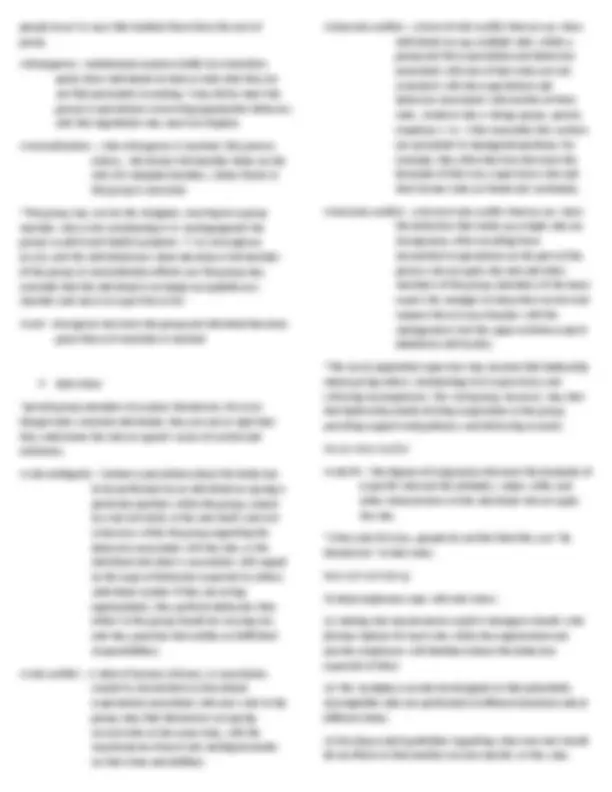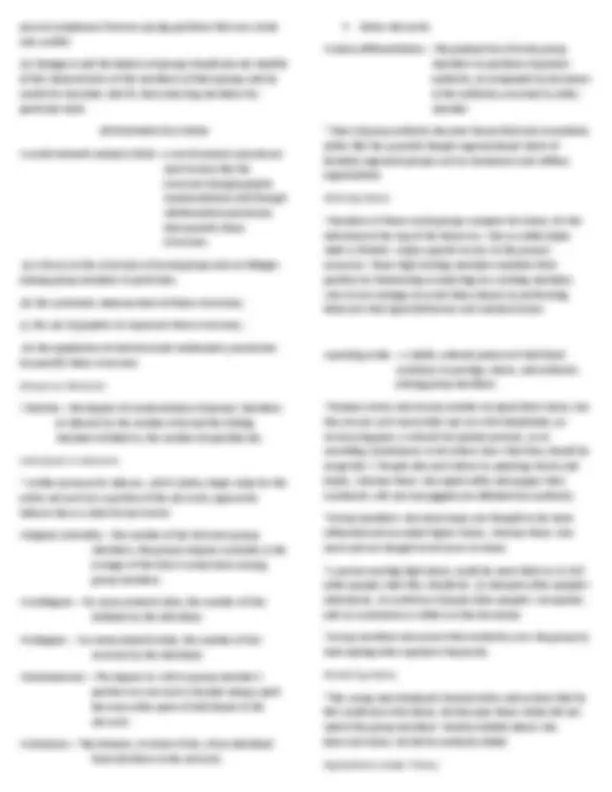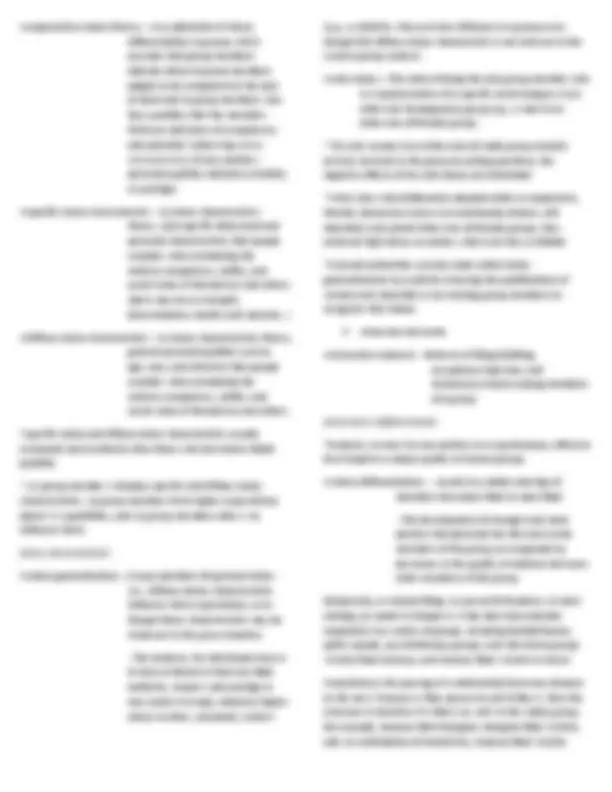





Study with the several resources on Docsity

Earn points by helping other students or get them with a premium plan


Prepare for your exams
Study with the several resources on Docsity

Earn points to download
Earn points by helping other students or get them with a premium plan
Community
Ask the community for help and clear up your study doubts
Discover the best universities in your country according to Docsity users
Free resources
Download our free guides on studying techniques, anxiety management strategies, and thesis advice from Docsity tutors
Group Dynamics Fifth Edition Forsyth
Typology: Lecture notes
1 / 7

This page cannot be seen from the preview
Don't miss anything!





On special offer
Chapter 6: Group Structure
- group structure —the underlying pattern of roles, norms, and networks of relations among members that define & organize the group - norms – defined and regulated members’ action *Despite widespread differences among groups, all share a common structural core: examining group structures is like studying an individual’s personality NORMS *Norms are the emergent, consensual standards that regulate group members’ behaviors. They are emergent , in that they develop gradually during the course of interaction among members—in some cases through deliberation and choice but often only gradually as members’ actions align. They are also consensual because norms are shared rules of action; norms are social standards that are accepted by a substantial proportion of the group. - prescriptive norm – A consensual standard that identifies preferable, positively sanctioned behaviours // define the socially appropriate way to respond in a social situation Ex. “Food should be shared equally,” “Those who are not injured should work to help those who are injured,” and “Follow the orders of the leader,” - proscriptive norm – A consensual standard that identifies prohibited, negatively sanctioned behaviours // ; they define the types of actions that should be avoided if at all possible Ex. “Do not urinate inside the airplane” and “Do not take more than your share of food and water.” - descriptive norm – A consensual standard that describes how people typically act, feel, and think in a given situation. Ex. In a business group, for example, most people arrive for the meeting on time. Very few people fall asleep during the meeting. Most people clap when the speaker finishes. - injunctive norm – An evaluative consensual standard that describes how people should act, feel, and think in a given situation rather than how people do act, feel, and think in that situation. *People who do not comply with descriptive norms may be viewed as unusual, but people who violate injunctive norms are negatively evaluated and are open to sanction by the other group members. // those who failed to do their fair share of work were criticized by the others, given distasteful chores, and sometimes even denied food and water Simple behaviors such as choice of clothing (“Wear shoes in public”), manners (“Do not interrupt others”), and conventions of address (“Call the professor ‘Dr.’”) reflect norms, but so do general societal principles of fairness (“Help others when they are in need”), morality (“Do not lie to members of the group”), and value (“Work hard for the group”). The Development of Norms *norm emergence process by taking advantage of the autokinetic (self-motion) effect: when people made their judgments in groups, their personal estimates blended with those of other group members *Over time, individuals with the highest and lowest estimates revise their judgments to match the group average. *Sherif confirmed that norms emerge, gradually, as group members’ behaviors, judgments, and beliefs align over time.
*even though the other group members were no longer present, the individuals retained the group norm internalized the norm *researchers gave groups feedback that suggested that their norm about how decisions should be made was causing them to make errors, but this negative feedback did not reduce the norm’s longevity across generations Because norms tend to resist revision, some group’s norms may seem pointless and arbitrary rather than reasonable and functional
- pluralistic ignorance – When members of a group privately vary in outlook and expectations, but publicly they all act similarly because they believe that they are the only ones whose personal views are different from the rest of the group
*even without a deliberate attempt at creating a formal group structure, the group will probably develop an informal role structure
- role differentiation – An increase in the number of roles in a group, accompanied by the gradual decrease in the scope of these roles as each one becomes more narrowly defined and specialized. *rapid proliferation of roles is typical of groups facing difficult problems or emergencies Types of Roles - task role – Any position in a group occupied by a member who performs behaviors that promote completion of tasks and activities, such as initiating structure, providing task-related feedback, and setting goals (task-oriented rationing of food supplies, organized work squads, others obey leader) - relationship role – Any position in a group occupied by a member who performs behaviors that improve the nature and quality of interpersonal relations among members, such as showing concern for the feelings of others, reducing conflict, and enhancing feelings of satisfaction and trust in the group (interpersonal and emotional need cheer up survivors, become positive and friendly) *A group may need to accomplish its tasks, but it must also ensure that the interpersonal and emotional needs of the members are met. For a group to survive it must meet… (1) : The group must accomplish its tasks (2) relationships among members must be maintained Why Differentiation? * few individuals can simultaneously fulfill both the task and the relationship needs of the group >Those who took on a task role (labeled the “idea man”) offered mostly suggestions and expressed opinions. >Those who gravitated to the relationship roles (labeled the “best-liked man”) showed solidarity, more tension release, and greater agreement with other group members. * Subsequent work suggests that this division of task and relationship roles is more likely when a group is experiencing conflict about its goals Group Socialization *individuals often seek particular roles in groups, but the group may not permit them to occupy these roles - group socialization – A pattern of change in the relationship between an individual and a group that begins when an individual first considers joining the group and ends when he or she leaves it. (individuals are often asked to take on roles that they would prefer to avoid) * group socialization is a mutual process; through assimilation, the individual accepts the group’s norms, values, and perspectives, and through accommodation, the group adapts to fit the newcomer’s needs *the belief that one is a newcomer who will be treated differently by the old-timers can act as a self-fulfilling prophecy: Just thinking of oneself as a newcomer caused
prevent employees from occupying positions that can create role conflict (4) Managers and the leaders of groups should also be mindful of the characteristics of the members of their groups and be careful to maximize role fit when selecting members for particular tasks INTEMEMBER RELATIONS
- social network analysis (SNA) – a set of analysis procedures used to describe the structure through graphic representations and through mathematical procedures that quantify these structures. (a) a focus on the structures of social groups and on linkages among group members in particular; (b) the systematic measurement of these structures; (c) the use of graphics to represent these structures; (d) the application of statistical and mathematic procedures to quantify these structures Groups as Networks
- expectation-states theory – An explanation of status differentiation in groups which assumes that group members allocate status to group members judged to be competent at the task at hand and to group members who have qualities that the members think are indicators of competence and potential. (observing status characteristics of one another – personal qualities indicative of ability or prestige) - specific status characteristic – In status characteristics theory, task-specific behavioral and personal characteristics that people consider when estimating the relative competency, ability, and social value of themselves and others. (basis may be on strength, determination, health, and maturity. ) - diffuse status characteristic – In status characteristics theory, general personal qualities such as age, race, and ethnicity that people consider when estimating the relative competency, ability, and social value of themselves and others. *specific status and diffuse status characteristics usually command more authority than those who lack status-linked qualities
Social Structures and Iteractions (SYMLOG)